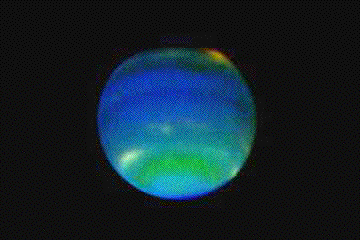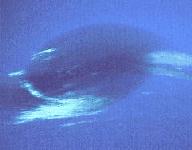Surface and Interior
of Neptune
 The Hubble Space Telescope has been used to assemble a time-lapse color
movie showing a full
16-hour rotation of Neptune. An animation of one rotation
is shown in the adjacent image; here is a more extensive
MPEG movie (492 kB)
made from a series
of Hubble observations
(Ref).
These images show
a powerful equatorial jet stream, immense storms, and dark spot in
Neptune's northern hemisphere
(more info).
The Hubble Space Telescope has been used to assemble a time-lapse color
movie showing a full
16-hour rotation of Neptune. An animation of one rotation
is shown in the adjacent image; here is a more extensive
MPEG movie (492 kB)
made from a series
of Hubble observations
(Ref).
These images show
a powerful equatorial jet stream, immense storms, and dark spot in
Neptune's northern hemisphere
(more info).
 The Voyager 2 flyby in 1989
revealed
strong winds, bright, high-altitude clouds, and two large
dark spots attributed to long-lived giant storm systems.
Tracking of these features indicated
wind speeds as large as 730
miles per hour. The largest dark storm systems, called
the "Great Dark Spot", is shown in the image adjacent left.
It resembles
Jupiter's Great Red Spot
(more info).
The Voyager 2 flyby in 1989
revealed
strong winds, bright, high-altitude clouds, and two large
dark spots attributed to long-lived giant storm systems.
Tracking of these features indicated
wind speeds as large as 730
miles per hour. The largest dark storm systems, called
the "Great Dark Spot", is shown in the image adjacent left.
It resembles
Jupiter's Great Red Spot
(more info).
The interior is presumed to contain a rocky core with an icy mantle topped by a
deep layer of liquid hydrogen. Voyager 2's instruments detected a complex
magnetic field. Like Uranus, the field is tipped with respect to the axis of
rotation and offset from the center (the tilt is 50 degrees for Neptune,
compared with 60 degrees for Uranus). However, the field is somewhat weaker
than for Uranus.
As for Uranus, it is speculated that this magnetic field my originate in a
conducting shell not far below the clouds, rather than deep in the interior as
for Jupiter or the Earth. In that case, the conducting material would not be
metallic hydrogen, as for Jupiter, or iron and nickel, as for the Earth. As
noted earlier for Uranus, a mixture of water, methane, and ammonia under the
right pressure could be responsible.
 The Hubble Space Telescope has been used to assemble a time-lapse color
movie showing a full
16-hour rotation of Neptune. An animation of one rotation
is shown in the adjacent image; here is a more extensive
MPEG movie (492 kB)
made from a series
of Hubble observations
(Ref).
These images show
a powerful equatorial jet stream, immense storms, and dark spot in
Neptune's northern hemisphere
(more info).
The Hubble Space Telescope has been used to assemble a time-lapse color
movie showing a full
16-hour rotation of Neptune. An animation of one rotation
is shown in the adjacent image; here is a more extensive
MPEG movie (492 kB)
made from a series
of Hubble observations
(Ref).
These images show
a powerful equatorial jet stream, immense storms, and dark spot in
Neptune's northern hemisphere
(more info).
